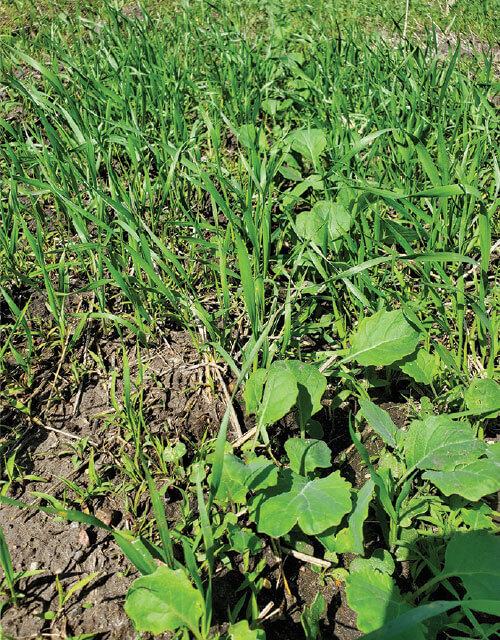Nasty weeds get an R rating
Weeds have become sexy, unfortunately, joining flea beetles, sclerotinia stem rot and clubroot on the naughty list. Weed management used to be fairly easy – back when herbicides worked without fail. This veil of decency has dropped, with R ratings becoming all too common. In these red-lighted alleys, “R” stands for resistant.
The Prairies have 23 weed species with confirmed herbicide resistance, as listed in the Saskatchewan and Manitoba crop protection guides. Of those, many have various resistant biotypes. A biotype is a weed species with a specific form of resistance. Wild oats with group 1 resistance and wild oats with group 2 resistance count as two biotypes. Manitoba has wild oat biotypes with stacked resistance to four groups – 1, 2, 14 and 15. Group 9 resistant weeds confirmed on the Prairies include kochia, downy brome and water hemp. Montana has Group 9 resistant Russian thistle.
In a Canola Council of Canada (CCC) survey of agronomy providers in August 2022, respondents ranked herbicide-resistant weeds number one when asked what canola agronomic risk factors are likely to be the greatest concerns for their farmer customers over the coming five years.
The threat also ranks high for farmers. A 2022 CCC survey of growers asked participants to name pests that present the greatest economic risk to their canola production. Herbicide-resistant weeds ranked third overall, behind flea beetles and sclerotinia stem rot, and second in the Brown soil zone.
Agriculture and Agri-Food Canada (AAFC) research scientists have done extensive weed surveys across the Prairies four times over the past 20 years. Surveys from 2014-17 found at least one herbicide-resistant weed biotype in 59 per cent of randomly sampled fields, up from 37 per cent in 2007-09 surveys and 16 per cent in 2001-03. In Saskatchewan in 2019 and 2020 surveys, 72 per cent of fields had a least one herbicide-resistant weed biotype.
Canola Watch has a more detailed version of these weed management practices. For the full article, read “Integrated weed management: Best practices” in the weeds section at canolawatch.org/fundamentals.
Charles Geddes, weed research scientist with AAFC in Lethbridge, Alberta, just published a paper called “Potential spring canola yield losses due to weeds in Canada and the United States.” The report compiled 89 yield-loss estimates from studies across the Prairies and North Dakota from 2003 to 2020. When weeds are not controlled, average canola yield loss was 30 per cent for Canada, the results show.
A 30 per cent drop in canola yields, based on 40 bu./ac. potential yield and $20 per bushel, would be $240 per acre. That is the cost of losing herbicide efficacy entirely. While complete loss is unlikely, it underlines the “critical need for canola farmers to diversify resistance selection pressures by implementing proactive integrated weed management programs,” Geddes concludes. What does a farmer do?
Tips to soften R ratings
How can the farmer-weed relationship return to beautiful days in the neighbourhood?
Shawn Senko, Canola Council of Canada agronomy specialist, says to start with scouting for problem patches. If a patch raises suspicions, consider asking an agronomist for a second option on identification and action, he says. The suite of actions include:
Make crops more competitive. Crops that achieve complete ground cover quickly can suppress weeds. For this objective, consider a combination of taller crops, narrow row spacing, shallow seeding depth, higher seeding rates and varied seeding dates.
Are those weeds resistant?
Escapes have a number of potential causes:
- The sprayer missed a patch. Clue: The patch includes many species of weeds and has a shape like a sprayer miss.
- The herbicide applied has limited activity on a particular weed. Double-check the product label for weeds listed as controlled.
- Herbicide rates and/or water volumes were too low to provide control on a particular weed. Clue: Escapes show up all across a field.
- Weeds were already too large for label rates. Clue: Escapes show some leaf damage but not enough to kill the plant.
- Weeds emerged after the herbicide application. Clue: Escapes are small, suggesting they emerged recently.
- Weeds are resistant. Clue: Most plants of that species were killed but an odd-shaped patch or a few random plants were not.
On dates, weeds like green foxtail, lamb’s-quarters, redroot pigweed and Russian thistle require more growing degree days to germinate and emerge, so an early-seeded canola crop could have an advantage over these weeds. However, cool season weeds like wild oats, quackgrass, wild mustard and stinkweed may present a problem with early seeding. Later seeding may be used to give more time for pre-seed burnoff, and it makes for a faster-emerging more competitive crop.
Tank mix herbicides from different groups. Hitting weeds with two or more modes of action effective on each weed reduces the risk of herbicide resistant weeds escaping and setting seed. If a weed is resistant to (or not controlled by) a Group 2 herbicide, a tank mix of Group 2 and Group 9 is not an effective tank mix. Geddes says canola cultivars with stacked resistance to glyphosate and glufosinate may offer growers an opportunity to manage kochia plants that survive glyphosate by following up with a rescue application of glufosinate.
Take steps to improve herbicide efficacy. Follow herbicide labels for timing, rates and water volumes as well as weather restrictions (frost, rain, heat) that may reduce efficacy. Early control is an important step, as herbicides are more effective on small weeds.
Take a whole rotation approach. A diverse crop rotation allows for different in-crop herbicide options. Consider crops that are more competitive, grow taller, have winter or perennial seasons, and allow for different harvest times.
Scout each field before and after herbicide application. A pre-application scout will identify the weeds present and their stage. This will determine what tank mix to use, and the herbicide rate required. Two weeks after spraying, check the field again to identify escapes or next flushes. (See the sidebar with tips to identify whether escapes could be resistant.)
Consider spot tillage. No-tillage is a valuable practice on the Canadian Prairies, and it depends on effective herbicides. In some cases, spot tillage or strategic tillage in some fields may be required to protect the usefulness of those herbicides essential to a no-till or reduced-tillage system.
Keep records. What weeds are in each field? What products were sprayed and other techniques used? Keep track of agronomy practices that may influence weed management and crop competition.
Use harvest weed seed control mechanisms. Combine weed destroyers, for example, can destroy almost all weed seeds that enter the combine. When Canola Digest asked its farmer panelists to share the best innovation they recently adopted on their farm, Josh Heidt from Kerrobert, Saskatchewan chose the Redekop weed seed destroyer. (Read the panel on page 26.) The combine-mounted mills pulverize chaff and the weed seeds within. “If herbicides are not going to work, we need to bring alternative methods to the table,” Heidt says.
That is how farmers will turn around these R ratings.
What does a farmer do if they have a major flush of resistant wild oats emerging at the same time as their canola crop?
Shawn Senko, CCC agronomy specialist, says, “If it’s Roundup Ready canola just stick with the glyphosate and watch those areas in case there are some escapes that need a second application. If LibertyLink canola and the field has a Group 1 resistant wild oat issue, money might be better spent upping the Liberty to the high rate instead of tank mixing in the Group 1 herbicide. Also, use the high water rate to ensure good coverage of the grassy weeds.” Charles Geddes, AAFC weed scientist adds: “We usually see much lower resistance to clethodim in wild oat compared with the other Group 1s. This means that the herbicide options should be good in either or LibertyLink or Roundup Ready canola. Higher rates are recommended especially if the wild oat are ahead of the canola.”






